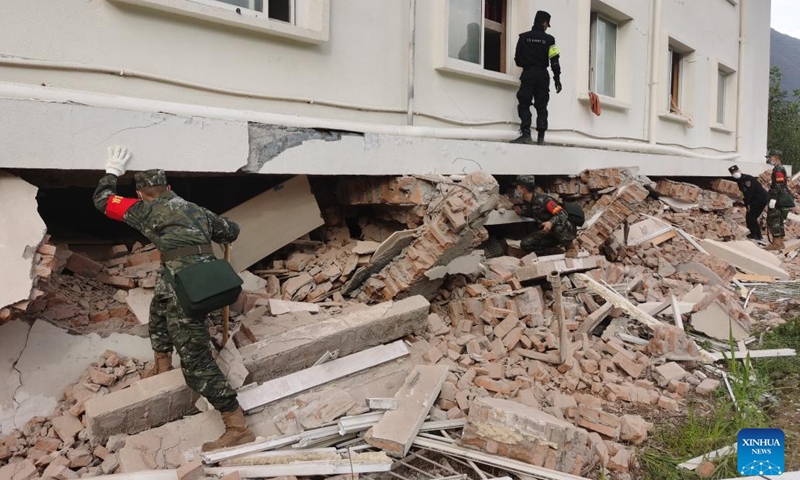
Rescuers search for survivors in Moxi Town of Luding County, southwest China's Sichuan Province, Sept. 5, 2022. A 6.8-magnitude earthquake jolted southwest China's Sichuan Province on Monday, leaving at least 21 people dead and more than 30 injured, causing damage to infrastructure facilities, such as the water and electricity supply, transportation and telecommunications.(Photo: Xinhua)
More than 50,000 people have relocated as of Tuesday morning after a
6.8-magnitude earthquake jolted Luding county in Southwest China's Sichuan Province on Monday, killing at least 66 people, leaving 15 missing.
As of 7:00 am on Tuesday, a total of 10 aftershocks of 3.0-magnitude or above have been recorded, including one earthquake of 4.0 to 4.9 magnitude, nine earthquakes of 3.0 to 3.9 magnitude, and the largest aftershocks of 4.2 magnitude so far, according to China Earthquake Networks Center.
At 2 am on Tuesday, more than 1,900 officers, armed police and soldiers of the People's Liberation Army PLA Western Theater Command rushed to the earthquake-hit area and arrived at the epicenter area at 8 am, engaging in transport of the injured, road dredging, victim search and other rescue work.
Among 66 deaths, 38 are in Garze Tibetan Autonomous Prefecture, where Luding county is located and 28 in Ya 'an city, a
s of Tuesday afternoon.One person was found dead and three found injured at the field station at the ecosystem observation and experimental station of the Chinese Academy of Sciences (CAS) on Gongga Mountain after the first floor of the station collapsed in the quake. The deceased victim was a graduate student from the University of Chinese Academy of Sciences, who was involved in scientific research at the station, according to a statement of CAS on Tuesday.
The Sichuan earthquake administration raised its prefectural emergency response for earthquakes to level I late Monday night, the highest in China's four-tier earthquake emergency response system. And the earthquake administration of China's State Council activated a level-II emergency response.
As of 7:00 am on Tuesday, more than 350 people have been stranded on Luding-Shimian Expressway, composing 336 construction workers and 20 managers. There were no reports of damage to other projects under construction, according to the Ministry of Transport.
Expressway tollbooths opened up over 700 special channels for earthquake relief. All service areas along the Chengdu-Luding Expressway have fully stocked with epidemic prevention supplies, oil products, food materials and other emergency supplies.
As of Tuesday morning, the power supply to nearly 22,000 households in the earthquake-striken area has been restored after overnight emergency repair, said the State Grid Sichuan Electric Power Company.
As Sichuan is tackling with the latest COVID-19 outbreak in China, authorities in Chengdu, the province's capital city where most of the residents are currently home quarantined, issued a statement on Tuesday, highlighting that residents should take good protection and evacuate safely first in case of earthquake, fire, flood and other disasters. Chengdu is about 220 kilometers from the epicenter.
The earthquake hit Luding county at 12:52 pm on Monday. The epicenter was monitored at 29.59 degrees north latitude and 102.08 degrees east longitude, at a depth of 16 kilometers in the county.




